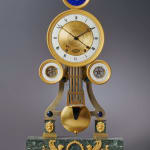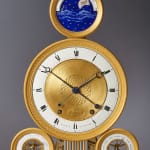Robert Robin French, 1742-1809
Literature
Derek Roberts, “Continental and American Skeleton Clocks”, 1989, p. 60, pl. 46A, illustrating a slightly later skeleton clock possibly by Verneuil, with fine enamel work by Joseph Coteau, featuring the same inverted Y-shaped frame and, as here, with a massive gridiron pendulum mounted on the front of the clock.
Tardy, “Les Plus Belles Pendules Françaises”, 1994, pp. 208-9, illustrating a Robert Robin Directoire skeleton clock with the main dial above a silvered calendar ring.
Jean-Dominique Augarde, “Les Ouvriers du Temps”, 1996, p. 155, pl. 121, illustrating a comparable Directoire multi-dial skeleton clock by Robert Robin in the Musée d’Horlogerie, La Chaux-de-Fonds, Switzerland.
An extremely rare Louis XVI gilt bronze, gilt brass and verde antico marble astronomical skeleton clock of month duration, signed on the white enamel chapter ring and also on a cartouche within the dial centre Robin au Louvre. The main dial with an engine turned centre and outer enamel chapter ring with Roman numerals and a fine pair of blued steel moon hands for the hours and minutes and a blued steel pointer for the sweep centre seconds. The main dial surmounted by a beautiful blue and gold star-studded lunar dial with clouds and a grisaille moon, marked above with indications for the 29 ½ days of the lunar month. The two subsidiary dials below, each with cut-out skeletonised centres and a pair of blued steel pointers, the one to the left with an enamel calendar ring marked with the months of the year and the corresponding numbers of days in each and inner ring for the 31 days of the month, the corresponding subsidiary dial to the right marked above with the days of the week and below with their respective symbols. The three barrelled movement with pin-wheel escapement, knife-edge suspension and a massive nine-rod gridiron compensated pendulum with five steel and four gilt brass rods, hanging from the front plate mounted below by a massive bob with fine regulation to the crutch. The finely polished inverted Y-shaped brass frame with each dial within a matching engine turned bezel, the whole resting on a pair of angular gilt bronze mounted verde antico pilasters, each with a foliate wreathed male mask mount, on a rectangular marble base mounted with a pair of winged lions holding a laurel wreath, on four bun feet
Paris, date circa 1790
Height 74 cm, width 40 cm, depth 16 cm.
Late eighteenth century skeleton clocks of this design and quality are extremely rare. This is because it was made by Robert Robin (1741-1799) who was not only one of history’s greatest horologists but as a leader in his field, he was constantly introducing new innovations. The fact that the clock has a three train movement is unusual, as too is the mounting of the pendulum on the front. Also very rare is the arrangement of the nine rod gridiron pendulum for unlike most compensated pendulums, the rods are angular rather than circular and each of the brass rods are gilded. Since it is such a rare piece only a few comparisons can be made. Of them one can cite another skeleton clock by Robin in the Musée d’Horlogerie at La Chaux-de-Fonds which, as here, has the pendulum mounted on the front plate. It has four subsidiary dials, one of which shows a Republican calendar ring. In contrast the present example was made prior to the Revolution and thus only shows the Gregorian time system. Another example, illustrated in Tardy, has again an inverted Y-shaped frame but differs from this piece in that the main dial ring is above a silvered annual calendar ring and that the pendulum is mounted at the back. A further comparable example by Robin dated 1784, with the pendulum and massive bob mounted on the front of the clock was sold at Antiquorum 11th November 2001, lot 48.
Skeleton clocks, where the case and dial are reduced to a minimum so as to reveal the complexity of the clock’s mechanisms, are some of history’s most prized horological works. Only the very best makers produced such pieces, counting among them Antide Janvier, Ferdinand Berthoud and Robert Robin. A brilliant horologist who made significantly advances in the quest for accurate time measurement, Robin was an ambitious man of great influence who achieved almost unrivalled success with a string of titles and important official posts to his name. Appointed to both Louis XV and Louis XVI as well as the latter’s wife and brother, his talents and the patronage of the royal family enabled him to count among his clientele the cream of the Parisian high society. Little is known of his early life but that he was born in Chauny, north east of Paris and in 1763 was appointed to Louis XV as Marchand-Horloger Privilégié du Roi. Having resigned from the post in 1765, he was received as a maître in 1767 by a decree exempting him from serving an apprenticeship. The most brilliant phase of his career began in 1778 when he was appointed Horloger du duc de Chartres and the Académie des Sciences approved two of his inventions. One was an astronomical clock, which the Menus Plaisirs acquired that year for Louis XVI.
Robin became famed for his mantle clocks, which featured astronomical indications and compensated pendulums among other complications. He also applied the same principal to regulators; among them was an early example that was acquired by the duc d’Aumont. Equally interested in watchmaking, from 1786 he used a special type of escapement, which he also incorporated into his monumental clocks, supplying for example those at the Grand Commune at Versailles in 1782 and at the Petit Trianon in 1785 – the year in which Louis XVI’s brother the comte d’Artois appointed him Horloger de Monsieur. Two years before, in 1783, he was appointed Valet de Chambre-Horloger Ordinaire du Roi and in 1786 was installed in lodgings in the Galeries du Louvre from where he was at the King’s disposal. Marie-Antoinette was so enchanted by his beautifully styled clocks that in 1786 she appointed him as her Valet de Chambre-Horloger Ordinaire du Reine with a salary of 400 livres and another 300 in bonuses. At least 23 clocks by Robin were listed in the 1793 inventory of her belongings while another ten were recorded as in the possession of the comte d’Artois. In addition to the ducs de Chartres and d’Aumont, other members of court and influential clients included the marquis de Courtanvaux, the maréchaux ducs de Duras and de Richelieu who acted as Premiers Gentilshommes de la Chambre as well as the marquis de Sérent, tutor to the ducs d’Angoulême and de Berry. After the overthrow of the monarchy, Robin was one of the first clockmakers to support the new Republican decimal time system introduced in November 1793. The following year saw his appointment as Horloger de la République, 1794 and then Horloger du Directoire in 1796.
As one of history’s truly great clockmakers, works by Robin continue to be prized among the world’s finest collections. Among them are the Musées du Louvre, Arts Décoratifs, National des Techniques, Conservatoire des Arts et Metiers and National d’Histoire Naturelle in Paris; the Wallace Collection, the Victoria and Albert Museum and the Guildhall in London as well Baron Rothschild’s former residence at Waddesdon Manor, Buckinghamshire. In addition, one can find examples of his work in America at the Frick Collection, New York; Cleveland Museum of Art, the Huntington Collection, San Marino and the Institute of Art Indianapolis, also at the Patrimonio Nacional, Spain; Pavlovsk and the Hermitage at Saint Petersburg; the Deutsches Museum, Munich and the Museum der Angewandten Kunst, Vienna.



